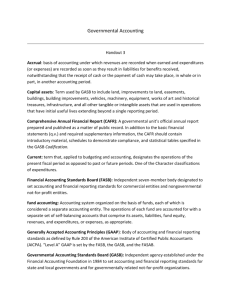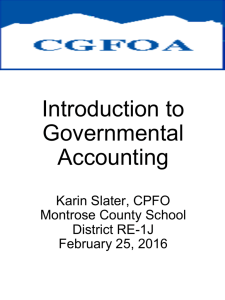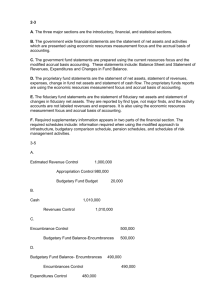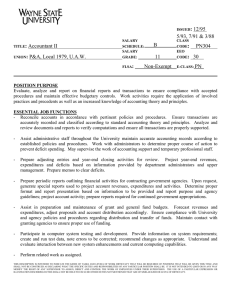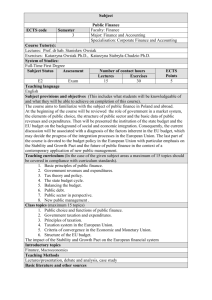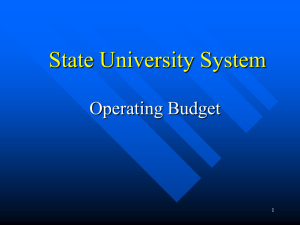Chapter 4 Accounting for Governmental Operating Activities
advertisement
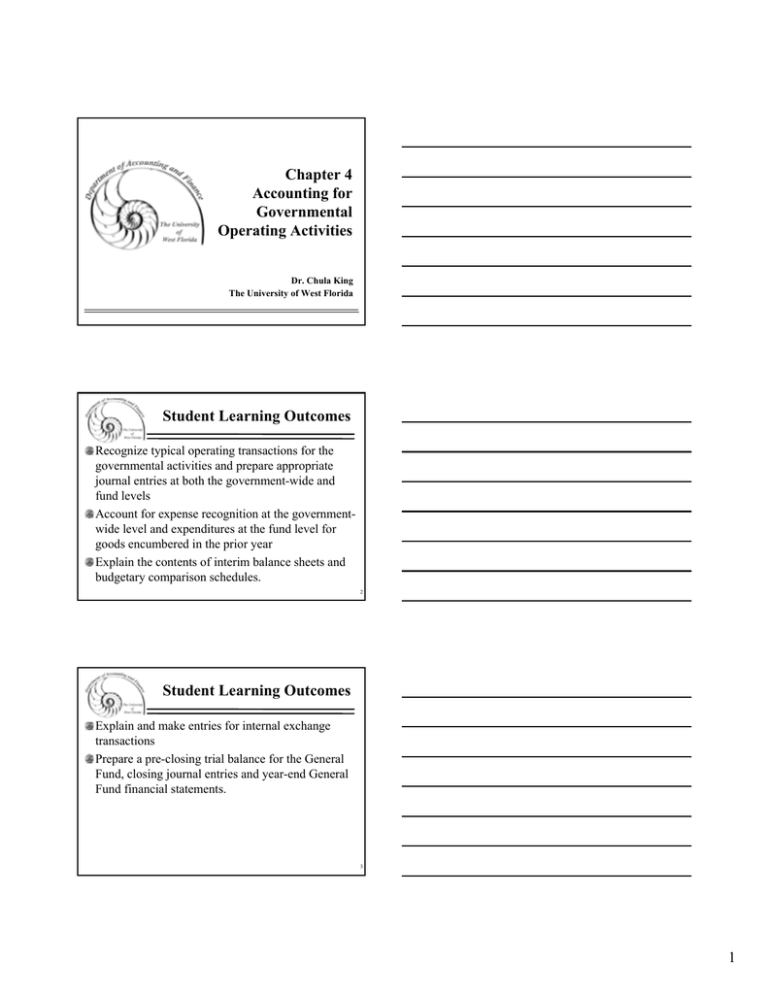
Chapter 4 Accounting for Governmental Operating Activities Dr. Chula King The University of West Florida Student Learning Outcomes Recognize typical operating transactions for the governmental activities and prepare appropriate journal entries at both the government-wide and fund levels Account for expense recognition at the governmentwide level and expenditures at the fund level for goods encumbered in the prior year Explain the contents of interim balance sheets and budgetary comparison schedules. 2 Student Learning Outcomes Explain and make entries for internal exchange transactions Prepare a pre-closing trial balance for the General Fund, closing journal entries and year-end General Fund financial statements. 3 1 Student Learning Outcomes Account for operating grants and other financial assistance using special revenue funds Account for interfund transactions; distinguish between intra- and inter-activity transactions; and explain accounting for intra-entity transactions Account for transactions of a permanent fund Explain the difference between exchange and nonexchange transactions, and the classifications of nonexchange transactions. 4 Governmental Funds Focus: measure the flow of current financial resources • Current financial resources include cash, receivables, marketable securities, prepaid items, and supplies inventories • Capital assets such as land, buildings, and equipment are not accounted for in governmental funds, but rather in governmental activities at the government-wide level Basis: modified accrual accounting. 5 Encumbrance Accounting Before a department can order materials and supplies or equipment, the finance department ordinarily must verify that a sufficient unexpended appropriation exists to cover the items being ordered This process is sometimes referred to as “preauditing.” 6 2 Appropriations, Encumbrances, Expenditures and Expenses Governmental Activities Fund Budget is Adopted Revenues Sub. Ledger Estimated Revenues (DR) Budget Recorded Appropriations (CR) Appropriations Sub. Ledger Encumbrances (DR) Encumbrances Sub. Ledger Funds are Encumbered Reserve for Encumbrances (CR) Reserve for Encumbrances Encumbrances Encumbrances Sub. Ledger Funds are Expended Expenditures Vouchers Payable Expenditures Vouchers Payable Vouchers Payable Cash Expenditures Sub. Ledger Vouchers Payable Cash Vouchers are Paid 7 Estimated Revenues and Revenues Governmental Activities Fund Budget is Adopted Revenues Sub. Ledger Estimated Revenues (DR) Budget Recorded Appropriations (CR) Receivable General Revenues Cash Receivable Revenues Accrued Receivable Revenues Receivable Collected Cash Receivable Appropriations Sub. Ledger Revenues Sub. Ledger 8 Example Assume that General Government, Public Safety and Public Works order materials and supplies amounting $80,000, $210,000 and $130,000 respectively for a total of $420,000: GF General Journal DR. Encumbrances – 2005 420,000 Reserve for Encumbrances-2005 Encumbrances Subsidiary Ledger General Government 80,000 Public Safety 210,000 Public Works 130,000 CR. 420,000 9 3 Accounting for Expenditures Expenditures were made for goods ordered as follows: General Government - $78,000, Public Safety - $220,000, and Public Works - $134,000. GF General Journal Dr. Cr. Reserve for Encumbrances 420,000 Encumbrances – 2005 420,000 Expenditures – 2005 Vouchers Payable 432,000 432,000 10 Accounting for Expenditures Governmental Activities Expenses-General Government Public Safety Public Works Vouchers Payable Dr. 78,000 220,000 134,000 Cr. 432,000 11 Accounting for Expenditures Encumbrances Subsidiary Ledger: General Government Public Safety Public Works Expenditures Subsidiary Ledger: General Government Public Safety Public Works Dr. Cr. 80,000 210,000 130,000 78,000 220,000 134,000 12 4 Accounting for Payroll Payroll accounting is similar for a governmental fund and a for-profit entity, except Expenditures rather than Expenses are recorded • Debit Expenditures for full amount of payroll and credit liabilities for withholdings from employees pay; credit Cash for the amount paid to employees • Record Expenditures for the employer’s payroll costs, including employer’s share of FICA and credit a liability to federal government Encumbrances usually are not recorded for recurring expenditures such as payroll. 13 Accounting for Payroll Payroll was recognized for the most recent two week pay period for employees in General Government-$178,000, Public Safety-$480,000, Public Works-$290,000: GF General Journal Dr. Cr. Expenditures—2005 948,000 Due to Federal Gov’t 86,000 Due to State Gov’t 49,000 Cash 713,000 Expenditures Subsidiary Ledger: General Government 178,000 Public Safety 480,000 Public Works 290,000 14 Accounting for Payroll Governmental Activities Expenses-General Government Expenses-Public Safety Expenses-Public Works Due to Federal Gov’t Due to State Gov’t Cash Dr. 178,000 480,000 290,000 Cr. 86,000 49,000 713,000 15 5 Accounting for Payroll The employer’s share of FICA is recorded. GF General Journal Dr. Expenditures—2005 86,000 Due to Federal Gov’t Expenditures Subsidiary Ledger: Contributions for Retirement 86,000 Governmental Activities Expenses-General Government 16,148 Expenses-Public Safety 43,544 Expenses-Public Works 26,308 Due to Federal Gov’t Cr. 86,000 86,000 16 Accounting for Property Tax Revenue The tax levy is the amount billed to taxpayers. Calculation of levy: Levy = [Statutory or legislatively approved tax rate x assessed valuation of taxable property (either real property or personal property)] An additional calculation of levy: Levy = Revenues required ÷ Estimated collectible proportion 17 Accounting for Property Tax Revenue The tax rate is the measure that is actually set by legislative action, after the required size of the levy is determined Required tax rate (per $100 or per $1,000 of assessed valuation) = tax levy ÷ assessed valuation. 18 6 Accounting for Property Tax Revenue Assessed valuation is determined by an elected “Tax Assessor” Calculation: Assessed valuation = Estimated True Value x Assessment Ratio In some jurisdictions the assessment ratio is 1.00 (i.e., full estimated market value), other jurisdictions it might be .30 or some other fraction of full value. 19 Accounting for Property Tax Revenue Assume Revenues of $495,000 are required and it is estimated that 1% will be uncollectible: GF General Journal Taxes Receivable-Current Est. Uncollectible Current Taxes Revenues Revenues Subsidiary Ledger Property Taxes Governmental Activities Taxes Receivable-Current Est. Uncollectible Current Taxes General Revenues-Property Taxes Dr. 500,000 Cr. 5,000 495,000 495,000 500,000 5,000 495,000 20 Accounting for Property Taxes Assume by end of year $450,000 of current taxes have been collected, the entry is: GF General Journal Dr. Cr. Cash 450,000 Taxes Receivable—Current 450,000 Governmental Activities: Same Entry 21 7 Accounting for Property Tax Revenue The entries to reclassify uncollected current taxes to delinquent status at year-end: GF General Journal Dr. Taxes Receivable—Delinquent 50,000 Taxes Receivable—Current Estimated Uncollectible Current Taxes 5,000 Estimated Uncollectible Delinquent Taxes Governmental Activities: Same Entries Cr. 50,000 5,000 22 Accounting for Property Tax Revenue Interest and penalties of $500 were accrued on delinquent taxes, of which 10% was estimated to be uncollectible. GF General Journal Dr. Cr. Interest & Penalties Receivable on Taxes 500 Est. Uncollectible Interest & Penalties 50 Revenues 4 50 Revenues Subsidiary Ledger Revenues 450 Governmental Activities Interest & Penalties Receivable on Taxes 500 Est. Uncollectible Interest & Penalties 50 General Revenues-Interest & Penalties 450 23 Accounting for Property Tax Revenues Write-off of uncollectible taxes. Assume property taxes of $500 were written off, on which there was accumulated interest and penalties of $80. The required journal entries are: GF General Journal Dr. Estimated Uncollectible Delinquent Taxes 500 Taxes Receivable—Delinquent Estimated Uncollectible Interest & Penalties 80 Interest and Penalties Receivable on Taxes Governmental Activities: Same Entries Cr. 500 80 24 8 Issuance of Tax Anticipation Notes (TANs) Revenues from property taxes are often collected during one or two months of the year Expenditure demands may occur more or less uniformly during the year A local bank may extend a line of credit in the form of TANs to meet short-term cash needs since it will have the power of lien over taxable properties. 25 Tax Anticipation Notes - TANs Assume that a 60-day $300,000 tax anticipation note, discounted at 6 percent per annum was signed. GF General Journal Dr. Cr. Cash 297,000 Expenditures—2005* 3,000 Tax Anticipation Notes Payable 300,000 * .06 X 60/360 X $300,000 = $3,000 Expenditures Subsidiary Ledger: Interest 3,000 Governmental Activities Cash 297,000 Expenses-Interest on TAN 3,000 Tax Anticipation Note Payable 300,000 26 Tax Anticipation Notes The 60-day $300,000 tax anticipation note was repaid on the due date. GF General Journal Dr. Cr. Tax Anticipation Notes Payable 300,000 Cash 300,000 Governmental Activities: Same Entry 27 9 Interim Balance Sheet (Ill. 4-2) Balance sheet equation at an interim point during the year (e.g., end of first quarter): Assets + Budgetary Resources = Liabilities + Fund Equity Fund Equity = Available Appropriations + Reserved Fund Balance + Unreserved Fund Balance 28 Interim Balance Sheet “Budgetary Resources” is the amount of unrealized estimated revenues to date (estimated revenues minus actual revenues) “Available Appropriations” is the amount of appropriations that has not yet been expended or encumbered. It is one component of Fund Equity at an interim point during the year. 29 Revision of Budgets Q: Why might a government need to revise its legally adopted budget during the year? A: An error may have been made in estimating revenues or expenditures, or changed conditions may have altered estimated revenues or caused unforeseen expenditure needs Because the budget is legally binding on managers, it is important that the budget be revised to reflect changed conditions. 30 10 Revision of Budgets Q: How are budget revisions accounted for? A: If estimated revenues is increased, debit Estimated Revenues and credit Fund Balance. • If appropriations are increased, debit Fund Balance and credit Appropriations. • A decrease in either item would result in the reverse of the above entry. • Subsidiary ledger detail accounts would be adjusted accordingly. 31 Closing Journal Entries Alternative methods, any of which is acceptable • Close Estimated Revenues and Revenues in one entry and Appropriations, Encumbrances, and Expenditures in a second entry, debiting or crediting Fund Balance as necessary in each entry • Close budgetary accounts (Estimated Revenues, Appropriations, and Encumbrances) in one entry and Proprietary accounts (Revenues and Expenditures) in a second entry, debiting or crediting Fund Balance as necessary, in each entry. • Close all temporary accounts in one entry, debiting or crediting Fund Balance as necessary 32 Year End Financial Statements General Fund Balance Sheet – Illustration 4-5 Statement of Revenues, Expenditures and Changes in Fund Balance – Illustration 4-6 Budgetary Comparison schedule – Illustration 4-7 Notes to the financial statements. 33 11 Special Revenue Funds Created when revenues are received that are earmarked for a specific operating purpose. Examples • motor fuel taxes earmarked for streets, roads, and bridges • federal grant to operate a counseling program for troubled youths • a gift received under a trust agreement that can be used only to purchase works of art for a public building Accounting, budgeting, and financial reporting are essentially the same as for the General Fund. 34 Accounting for Operating Grants Assume a grant of $100,000 is received at the beginning of the fiscal year from the federal government to operate a counseling program for troubled youths. Until the grant has been “earned” by meeting eligibility requirements related to service recipients, it is reported as “Deferred Revenue” – a liability. The entry in the special revenue fund is: Cash Deferred Revenue Dr. 100,000 Cr. 100,000 35 Accounting for Operating Grants Assume that during the year the Counseling Program expended $75,000 for costs related to youth counseling, while meeting eligibility requirements, the entries would be: Expenditures Vouchers Payable Deferred Revenues Revenues Dr. 75,000 Cr. 75,000 75,000 75,000 (This amount would also be recorded in the Revenue detail account in the Revenue subsidiary ledger.) 36 12 SRF-Required Financial Statements Report special revenue fund activity in the governmental activities section of the government-wide financial statements. Provide a column in the governmental funds balance sheet and statement of revenues, expenditures, and changes in fund balances, if SRF meets the definition of a major fund (see Ill. 1-7) 37 Internal Exchange Transactions Transactions between two funds that are similar to those involving the government and an external entity • Example: Billing from a City’s water utility fund (an enterprise fund) to the City’s General Fund for the Fire Department Funds recognize a revenue and expenditure, rather than operating transfers in and out These transactions are eliminated prior to preparing the government-wide financial statements. 38 Interfund Activity Interfund loans • Loans made from one fund to another with the intent that they are to be repaid • Classified as “Interfund Loans Receivable – Current (or Payable-Current)”, if the intent is to repay during the current year; otherwise “Noncurrent”. Interfund transfers • Nonreciprocal activity in which other financing sources and uses are transferred between funds with no intention of repayment. 39 13 Intra- versus Inter-Activity Transactions Intra-activity transaction: A transaction between two governmental funds (including an internal service fund) or between two enterprise funds. Neither governmental activities nor business-type activities is affected at the government-wide level. Inter-activity transaction: Interfund loans or transfers between a governmental fund (including internal service fund) and an enterprise fund. Report these as “Internal Balances” on the government-wide Statement of Net Assets and “Transfers” in the Statement of Activities. 40 Intra-Entity Transactions Exchange or nonexchange transactions between the primary government and its blended or discretely presented component units A/R and A/P from these transactions are reported on a separate line in the Statement of Net Assets. 41 Permanent Funds To account for contributions received under trust agreements in which the principal amount is not expendable, but the earnings are Specifically intended to meet a public-purpose i.e., to benefit a government program or function, or the citizenry, rather than an external individual, organization, or government. A new classification under GASBS 34; formerly classified as nonexpendable Fiduciary Funds. 42 14 Exchange Transactions Transactions in which each party receives value essentially equal to the value given • e.g., one party sells goods or services and the other buys Recognize the revenue when it is earned, and the expense/expenditure when it is incurred Exchange-like transactions are those in which the values exchanged may be related but not quite equal. 43 Nonexchange Transactions External events in which a government gives/ receives value without directly receiving/giving equal value in exchange Revenue recognition depends on time requirements - the period in which the resources are required (or may be) used In some cases, revenue recognition may be delayed until program eligibility requirements are met Purpose restrictions reported as restricted net assets or reserved fund balance. 44 Classes of Nonexchange Transactions Derived tax revenues, e.g., income and sales taxes Imposed nonexchange revenues, e.g., property taxes and fines and penalties Government-mandated nonexchange transactions, e.g., certain services funded by a higher level of government Voluntary nonexchange transactions, e.g., grants and entitlements from higher levels of government and certain private donations. 45 15 Revenue Recognition Criteria for Nonexchange Transactions Derived tax revenues: in the period in which the underlying exchange occurs Imposed nonexchange revenues: when there is an enforceable legal claim or the period for which levied in the case of property taxes Government-mandated and Voluntary nonexchange transactions: when all eligibility requirements have been met. If cash is received before eligibility requirements have been met, 46 Deferred Revenues would be credited. Concluding Comments Mastery of the revenue and expenditure accounting principles covered in Chapter 4 is essential to a sound understanding of governmental fund accounting, as well as understanding accounting and financial reporting for the other governmental funds discussed in the following chapters. The General Fund and special revenue funds encompass most of the operating activities of the typical government. 47 The Next Step Chapter 4 – City of Smithville simulation. Due no later than midnight, CDT, June 12 Chapter 4 – CAFR assignment. Due no later than midnight, CDT, June 12 Problem 4-2, 4-6, 4-7, 4-8. 48 16
